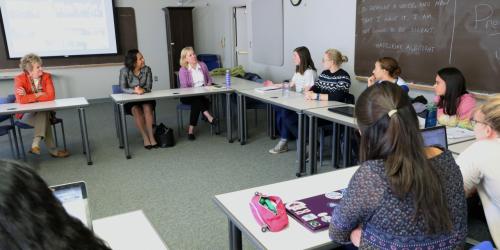Students in Writing 177: Physical Activity and Cognition, a new course for first-years, welcomed a special guest on November 14: President Paula A. Johnson, who asked what the group had researched for their third essay of the semester. One by one, the students described their topics—reducing teen pregnancy through education, eliminating food deserts, tackling prescription drug abuse—and how those issues might be addressed from a social and cultural standpoint. Johnson listened intently, suggested relevant facts and angles, and complimented the students on their thoughtful approaches.
“Her input was much appreciated, especially given her deep understanding of women’s health issues and her emphasis on the importance of students’ well-being,” said Connie Bauman, Physical Education, Recreation, and Athletics (PERA) professor of the practice, who developed and team-teaches Writing 177 with Jeannine Johnson, director of the Writing Program and a lecturer in writing. Together, the two help students develop their writing muscles, so to speak, as they learn about the relationship between exercise, academic performance, and overall well-being.
The course began with readings and discussions about the history of physical activity at Wellesley, which dates back to when founder Henry Durant insisted that students exercise an hour each day so that they could withstand the academic rigors of College life. That directive was replaced in time as Wellesley, like many other colleges, required students to complete two physical education classes as part of their degree requirements. (Wellesley is one of the few institutions that still requires students to take physical education; the College considers it part of a liberal arts education.)
“Durant did not have supporting research for his claims, as we do now,” said Bauman. “For more than a decade, neuroscientists and physiologists have been gathering evidence of the beneficial relationship between physical activity and brainpower. One’s mental fitness is positively influenced by being physically and cognitively active.”
During the twice-weekly classroom sessions, students learned what current research shows about exercise, stress, and the brain and how public health initiatives can affect well-being. They discussed the elements of good writing and tips for public speaking, and they had to speak clearly and concisely about their essay ideas during two-minute lightning rounds.
Physical activity is integral to the course; in fact, students take a five-minute stretching break, under Bauman’s direction, midway through each class. They also have a weekly physical education lab, where they learn yoga and meditation routines, take walking tours of campus, learn about nutrition, and track their heart rates and activity levels using Fitbits and iPads they were given at the start of the course.
Developing an awareness of habits and choices is crucial to improving health, said Bauman and Johnson. The same is true with writing.
“We want students first and foremost to develop and maintain an awareness of audience. When they have the sense that they are writing to someone and for someone, they will feel that their ideas matter and that their writing can educate and inspire others,” said Johnson.
She continued, “Being mindful and respectful of a reader also means that we have to work very hard to ensure that our ideas are well-considered (acknowledging, for example, counter-argument) and that they are articulated precisely. Achieving the latter means paying close attention to everything from word choice to paragraph structure to transitions to titles. And it means engaging in repeated, rigorous revision.”
That emphasis on learning and practicing skills highlights the connection between writing and fitness. It also allows students to see their progress, which is encouraging, both instructors said.
Students agree. “This class has really helped me with the writing process as a whole,” said Harriet Atkins ’20, who intends to major in computer science. “Going into this class, I knew that exercise was obviously good for you, but I really loved learning about its health benefits in more detail.”
“I think I have gotten better at revising my papers,” said Chloe Kaplan ’20, who plans to major in biology and took the course because of its “interesting, interdisciplinary approach” to writing. “Also, I have learned the importance of exercising as it relates to my happiness and personal health.”
Bauman is happy to hear that. She has always wanted to teach an academic course that focuses on the “whole student,” she said, and helps students develop lifelong health and wellness skills.
Maggie Haley ’20 said she applies many of the writing lessons she has learned in her everyday life. She also has begun moving more, because of the Fitbit, and now tracks her steps and heart rate each day.
“This class will most likely go down as one of the best decisions I have made at Wellesley,” said Haley. “I am so sad I can’t take it again next semester.”




